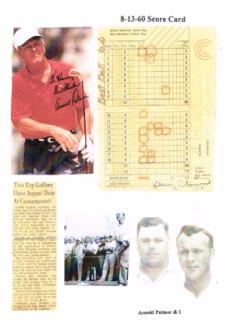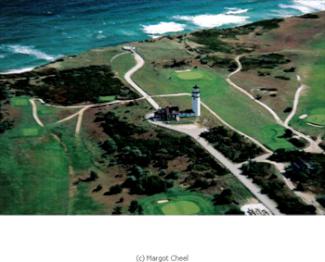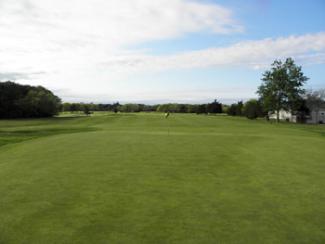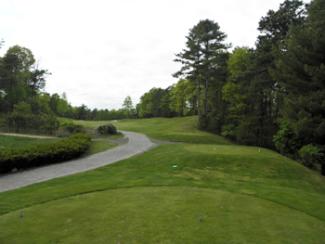Featured Golf News
Five Intriguing, Historic Holes on Cape Cod
There are nearly 40 public and private golf courses on Cape Cod featuring holes that parallel the ocean, wind around cranberry bogs, meander between tall pine trees, and even one where a century-old lighthouse serves as the backdrop.

Arnold Palmer's Visit to Cape Cod CC
is Remembered Today
Some holes are especially intriguing, for their history, their distinctiveness or their scenic backdrop. Here are five on Cape Cod that stand apart.
The 14th at Cape Cod Country Club, East Falmouth
The year was 1960 and Arnold Palmer was just beginning to earn his nickname as "The King." Fresh off victories in the Masters and the U.S. Open earlier that summer, Palmer came to Cape Cod Country Club in August to play an exhibition match against Billy Casper, the 1959 Open champion.
The 14th hole is a par-4 that plays 365 yards from the tips. But length is not the challenge. It is called "The Volcano" for the cone-shaped elevated green that kicks even slightly off-line approach shots down an embankment into the woods, leaving a delicate, difficult uphill chip to a narrow putting surface.
The course hosted three consecutive Massachusetts Open championships in the 1950s, and when John Thoren won in 1955, he didn't even attempt to reach the green in two shots. Instead, he purposely left his ball short, then successfully chipped onto the green and one-putted for par.
That was the backdrop for the hole when a 30-year-old Palmer arrived five years later. The club, originally opened in 1928 as a nine-hole course, was then operated by Harvey G. Clausen, a big man with big ideas. After winning the Open, Palmer had requested a heftier appearance fee than originally agreed upon. "But my father wasn't going for that. He stuck to his guns," remembers Clausen's daughter, Elizabeth.
Instead, Clausen bet Palmer $50 that he couldn't par the 14th hole. Palmer countered with a $100 wager if he could make birdie. The King knocked his second shot onto the green and rolled in the putt for a 3, collecting the equivalent of nearly $800 in today's value.

An Aerial View of Highland Links & Historic Lighthouse
The Seventh at Highland Links, Truro
Journalist Alistair Cooke once called Highland Links "the perfect example of British or Scottish links in the United States." Built in 1892, it is the Cape's oldest course - and looks every bit its age. Only nine holes, this par-35 measures out at barely more than 2,500 yards. But if you love golf history, you'll quickly understand that simplicity is the point.
Francis Ouimet, winner of the historic 1913 U.S. Open at The Country Club in Brookline, played an exhibition round at Highland before the greens were converted from sand to grass. The original course stood next to an ocean-side hotel and cottage resort. Both are long gone, replaced by the Truro Historical Museum.
The 170-yard seventh hole provides an especially memorable experience. Highland Light, the oldest and tallest lighthouse on Cape Cod, serves as the backdrop. George Washington authorized the station and lighthouse in 1797. The original wood structure was replaced by brick in 1833, with the entire structure being demolished and replaced in 1857. In danger of tumbling down the cliff due to beach erosion, it was moved to its current location behind the seventh green in 1996. After a golf ball shattered a window, unbreakable material was installed.

Hyannisport Club's 14th Hole
14th at Hyannisport Club, Hyannisport
As you stroll down the fairways of this majestic course with views of Nantucket Sound, close your eyes and imagine what the scene was like in 1963 when Marine helicopters carrying an entourage of government officials landed alongside the 14th hole.
The Summer White House was within walking distance of the golf course during John F. Kennedy's administration, and JFK would often sneak in a few holes in the late afternoon. He would phone the pro shop to inquire if the first tee was open, and then would stroll up Irving Avenue from the Kennedy Compound holding his golf shoes in one hand and carrying a change of clothes in the other. He'd sit on a wooden stool in the bag room to lace up his shoes.
The club pro, Tom Niblet, recalls the day when Kennedy personally called to cancel a golf lesson, telling him that "something came up." Minutes later, helicopters were seen landing alongside the 14th hole and JFK was being briefed on issues related to Southeast Asia.
Kennedy once invited Niblet to join him for nine holes. Niblet striped a drive on the first tee, as did the second member of the foursome. Kennedy put his driver back into his bag, pulled out a 5-wood and drove it 175 yards down the middle. "I never wanted to be a big hitter," he said. "I just like to be with big hitters."
After finishing nine holes, Kennedy thanked Niblet and said, "Tom, we'll do this more often."
It was August 18, 1963. "We never had the chance," Niblet said.
The Sixth at Bass River Golf Course, South Yarmouth
Opened in 1900 as a private nine-hole club, legendary golf architect Donald Ross redesigned and expanded the course to 18 holes in 1914. As Bass River celebrates the 100th anniversary of Ross's creation, the 169-yard par-3 sixth remains the signature hole. Golfers hit OFF an elevated tee, across marshland, to a severely sloped green with a steep embankment in front.
Shots that land short will catch the bank and tumble down the hill into the hazard. Hit it left and there's a bunker waiting or, even worse, a rock-strewn cliff. Take too much club and you're faced with a treacherous downhill pitch. If that isn't enough to make your knees wobble, the hole runs alongside the Bass River, which usually means a howling crosswind.
Perhaps the most memorable shot on the hole came in the 1970s during a charity event when a competitor scored an ace to win a new car. Or so he thought. The insurance company had stipulated that the tees be at a certain distance and resisted paying off. It took some wrangling and the threat of a lawsuit, but the car was eventually awarded.

Willowbend's 8th Hole
Eighth at Willowbend Club Bay Course, Mashpee
Many of the greatest names in golf have walked Willowbend Club's fairways to play in charity tournaments, including Greg Norman, Tom Watson, Nick Faldo and Gary Player. But only one appeared the morning after capturing a major championship.
In 2011, Rory McIlroy came to Willowbend hours after winning the U.S. Open at Congressional in Bethesda, Md., to honor a sponsor commitment at a Monday outing. With the Open trophy in the backseat and little sleep following a night of celebrating, a bleary-eyed McIlroy arrived with the outing already in progress and was hustled onto the course without benefit of a warm-up swing.
By the time he reached the dogleg-right eighth, he was fully loose. The green isn't visible from the tee, but that didn't deter the young Northern Irishman. Selecting 3-wood, he bombed his drive 311 yards over the trees and onto the green.
If you're ever uncertain about the difference between a pro golfer and the weekend warrior, the view from the tee on the eighth hole at Willowbend's Bay Course will provide a clear answer.
Rob Duca is an award-winning sports columnist who wrote for the Cape Cod Times for 25 years, covering golf, the Boston Red Sox, the Boston Celtics and the Boston Bruins. He is now managing editor of New England Golf & Leisure magazine and has written for a variety of other publications, including Sports Illustrated, the Boston Globe, Yankee magazine and Cape Cod Life.
Story Options
 |
Print this Story |
